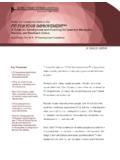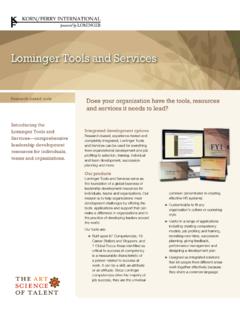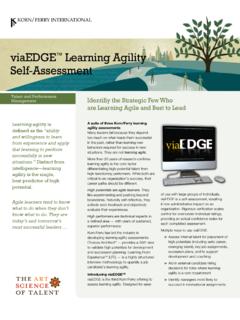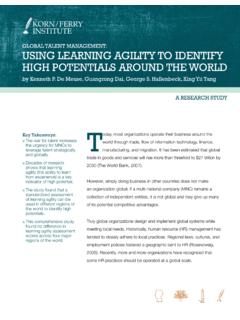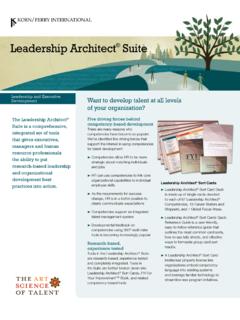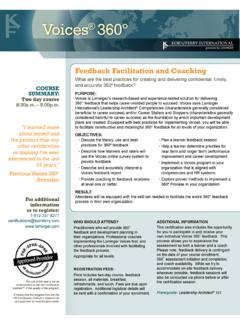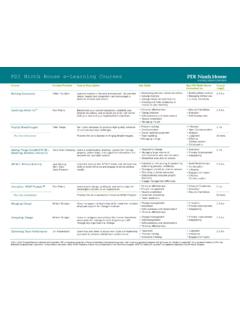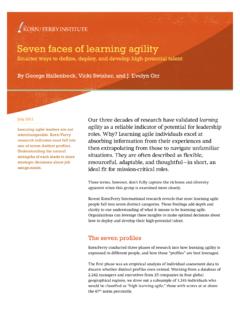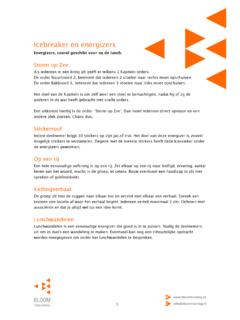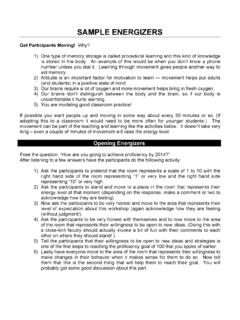Transcription of Seven faces of learning agility - Korn Ferry
1 Seven faces of learning agility Smarter ways to define, deploy, and develop high-potential talent By George Hallenbeck, Vicki Swisher, and J. Evelyn Orr July 2011 Our three decades of research have validated learning learning agile leaders are not agility as a reliable indicator of potential for leadership interchangeable. Korn/ Ferry roles. Why? learning agile individuals excel at research indicates most fall into absorbing information from their experiences and one of Seven distinct profiles. Understanding the natural then extrapolating from those to navigate unfamiliar strengths of each leads to more situations. They are often described as flexible, strategic decisions about job resourceful, adaptable, and thoughtful in short, an assignments. ideal fit for mission-critical roles. Those terms, however, don't fully capture the richness and diversity apparent when this group is examined more closely. Recent Korn/ Ferry International research reveals that most learning agile people fall into Seven distinct categories.
2 These findings add depth and clarity to our understanding of what it means to be learning agile. Organizations can leverage these insights to make optimal decisions about how to deploy and develop their high-potential talent. The Seven profiles Korn/ Ferry conducted three phases of research into how learning agility is expressed in different people, and how those profiles are best leveraged. The first phase was an empirical analysis of individual assessment data to discern whether distinct profiles even existed. Working from a database of 2,242 managers and executives from 25 companies in four global geographical regions, we drew out a subsample of 1,245 individuals who would be classified as high learning agile, those with scores at or above the 67th norm percentile. That subsample was then analyzed looking at scores on the four factors of learning agility : Mental agility , People agility , Change agility , and Results agility . Any strong deviations from the norm were flagged and then the data set was re-examined to see if patterns started to emerge from these deviations.
3 learning agility : Knowing what to do when you don't In the end we found that Seven distinct profiles described approximately know what to do two-thirds of the high learning agility people. learning agility is the ability and willingness to learn from experience and then apply that Much like personality types, no profile is better or worse than the others. learning to perform successfully in new Each has its own combination of strengths and developmental needs. Below situations. is a brief summary of the Seven profiles. (Extended descriptions are People who are learning agile: provided in Lominger's High learning agility Profiles tool.). > Seek out experiences to learn from. Problem Solvers: Given an ambiguous problem, they explore its > Enjoy complex problems and challenges complexities, develop a notion of what will work, and then set about associated with new experiences. resolving the situation with a mix of drive and resourcefulness. Along the way, they seek to involve others and leverage their abilities.
4 This is > Get more out of those experiences the most frequently occurring of the Seven profiles and most closely because they have an interest in making sense of them. fits the classic definition of a high learning agile person. > Perform better because they incorporate Thought Leaders: Determined seekers of insight and truth, they ask new skills into their repertoire. hard questions and strive to make difficult connections. They are A person who is learning agile has more committed to seeing progress; however, they tend to function best lessons, more tools, and more solutions to behind the scenes versus being out-front champions for change. draw on when faced with new business challenges. Trailblazers: They have a clear sense of where they need to be and are determined to make it there, sometimes by whatever means are available. Laser-focused and confident in their approach, Trailblazers are at home where others fear to tread. Champions: Like the hero in a classic tale, individuals fitting this profile have a flair for saving the day in grand style.
5 They can handle difficult situations with humor and grace. By focusing primarily on people and results, they also allow others an opportunity to shine. Pillars: Pillars put considerable effort into crafting and implementing highly refined solutions, but tend to focus more on creating an improvement than making a dramatic change. They lead with a harmonious blend of insightful thinking, focused action, and an open, inclusive manner. Diplomats: When the stakes are high and the situation calls for smooth people skills, these are the individuals you want to be at the forefront. They are deft at sizing up others and can adjust their style to fit the moment. 2. energizers : Achievement-oriented, extremely hardworking, and able to inspire others, energizers establish larger-than-life, almost iconic reputations. energizers put together a committed and capable team and always get the job done. Further testing of the profiles in companies outside our original research sample reinforced our findings.
6 In some organizations, 75 percent or more of high learning agile people can be classified into one of these Seven profiles. Getting to know the profiles face-to-face The next research phase consisted of in-depth interviews with individuals in senior-level roles at a major global retailer to see each profile in action. After being matched to a specific profile using Choices , a validated Source of the profiles assessment of learning agility (see sidebar), executives were asked about a wide range of topics including situations where they felt they had applied The Seven learning agility profiles were derived from data gathered using the their strengths well and situations where they had struggled or learned Choices assessment, which measures lessons the hard way. Some non-work-related questions, such as who were learning agility . persons they admired, were also asked to provide a broader sense of them as individuals. Finally, they were told about their specific profile and asked Organizations use Choices to objectively identify high-potential talent so that they might for their reaction.
7 Better deploy people who will learn the most from their experiences and assignments. These interviews reinforced many of the perceptions that had been formed Empirical research indicates that Choices from the initial data-driven analysis. The executives' comments and scores predict other criteria of success, anecdotes made the profiles and some of their distinct qualities come to including supervisor rating of promotability life. and performance rating after promotion. The Problem Solver: Happy tackling the tough ones Problem Solvers seem to naturally enjoy immersing themselves in just about any conundrum that comes their way. One interviewee noted that he enjoyed being in a centrally located office specifically because people frequently stopped by to say, I have a problem or Here's one that's tough. Not only did he engage in finding the solution, he wanted to coach others on how to tackle a tough problem. I love coaching people through stuff to help them discover the outcome.
8 I'm particularly excited when it gives me an opportunity to be creative or encourage others to be creative in the solution. Problem solvers don't confine their efforts to the workplace. Whether it is learning to swim for a triathlon or immersing themselves in an unfamiliar city, there are always new things for them to explore and understand. The Thought Leader: Making an impact from the wings One of the Thought Leaders we spoke with had a role as a communications manager. She hated being in the spotlight or public speaking, but took 3. great pride in speech writing for executives and coaching them toward success. A memorable success occurred when working with an executive with a history of rocky presentations, and thus low confidence. Through intense partnering, practice, and feedback the Thought Leader guided the executive to a standout presentation. I would never want to be on stage giving the speech, she reflected, but there is nothing more exciting than seeing a person whose speech you wrote get a high score or a standing ovation.
9 That person now wants to work with me again.. The Trailblazer: Getting to results Trailblazers are distinguished by their courage and persistence; they let very little, if anything, get in their way. Some Trailblazers have gained perspective on their hard-driving ways. While they can still get quite animated about results (especially when they aren't up to expectations), they have learned to moderate their style to get the best out of others voluntarily versus pushing them to extremes. Said one Trailblazer, I have matured in my leadership style I have learned to tap into what makes others tick and have been much more successful with that. In the past, during the first fifteen years of my career, I would have been much more of a jump on the train or else' kind of guy.. The Champion: No micromanaging, please Champions are predisposed to take an idea and run with it: Leave me alone and let me do it is their credo. One interviewee recalled her assignment to start a new line of business in a very hard-to-break-into space.
10 She translated the we've never done it; let's be conservative attitude of her leaders into a call to action. She was energized by the challenge because no plan or process existed to get results; it required improvisation and what she referred to as guerrilla business strategy. In less than a year, her results were double her goal. The Pillar: Tell me what you really mean Of the profiles, Pillars struggle the most with highly ambiguous situations. That doesn't mean that they like everything spelled out, but they appreciate a supervisor who is straightforward and doesn't offer pre-packaged sound bites. When asked what he looked for in a boss, one Pillar said, Someone who can reduce spin. Someone who is the filter. Someone who tells us what we need to do, when we need to do it by, but doesn't tell us how to get there. Someone who's clear on expectations and deliverables, but lets us have the creativity to figure out how to do it.. The Diplomat: Bridging distances Diplomats thrive on developing intense connections with others and forming trusting bonds.
